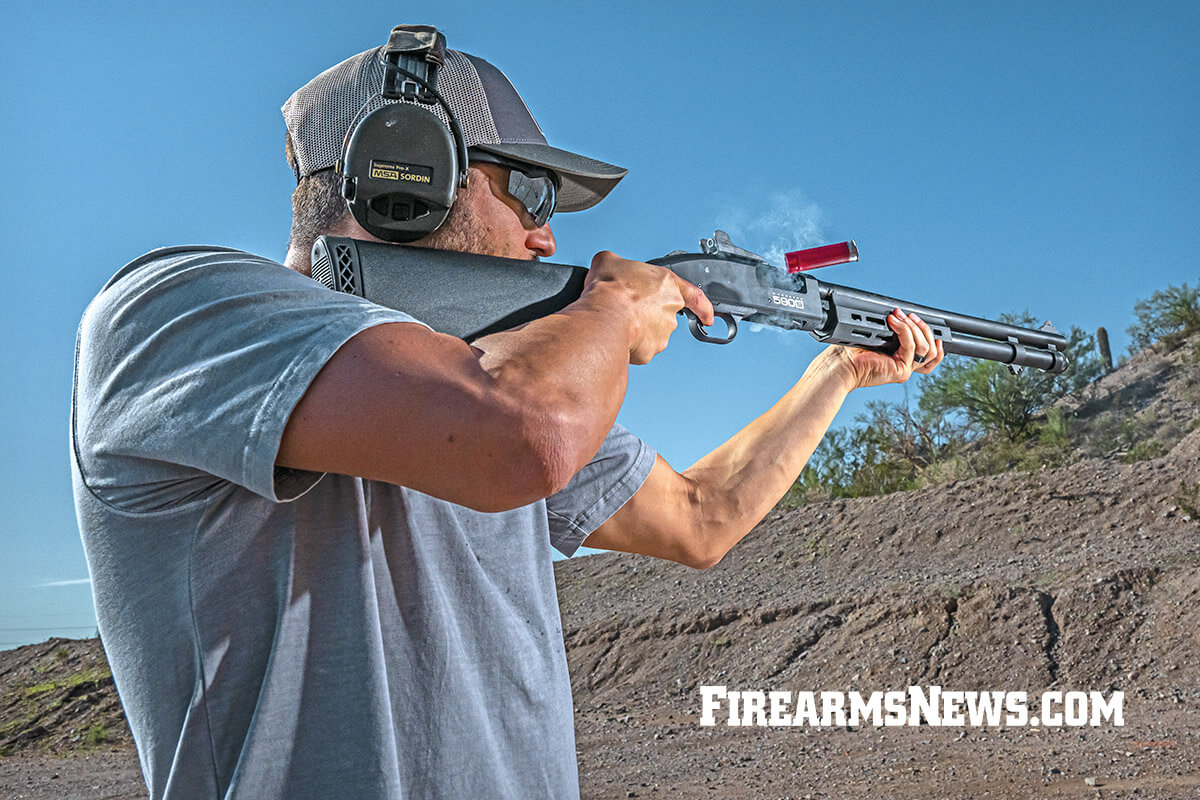
Mossberg 590S Pump-Action Defensive Shotgun (Photo by Sean Utley)
If an eight-plus-one pump shotgun is good, how do you make it better? Add more shells without adding length or bulk. That’s the magic Mossberg has done here in the Mossberg 590S. Which one is that, in the rack full of Mossberg shotguns? The one with the big “590S” laser-engraved on the right side, that one. It is hard to believe that the Mossberg 500 came out in 1962. The world was so different; gasoline cost 31 cents a gallon, equal to $2.90 today. Car sales then had been in the tank, having dropped from the high of 7.4 million in 1955, down to only 5.9 million in 1961. (No worries, it would soon zoom up to 9.3 million in 1965, and never drop below 8 million a year until 2003.) Average family income was $5,700, which equates to $52,300 in Biden dollars. The Mossberg 500 had a list price of $75, compared to the Ithaca 37 at $98, the Remington 870 at $90 and the Winchester M12 at $109. Some things were no different back then than they are today. A lot of people feel a pump shotgun is ultra-reliable (they are correct) and a good choice for personal defense. (Again, correct.)
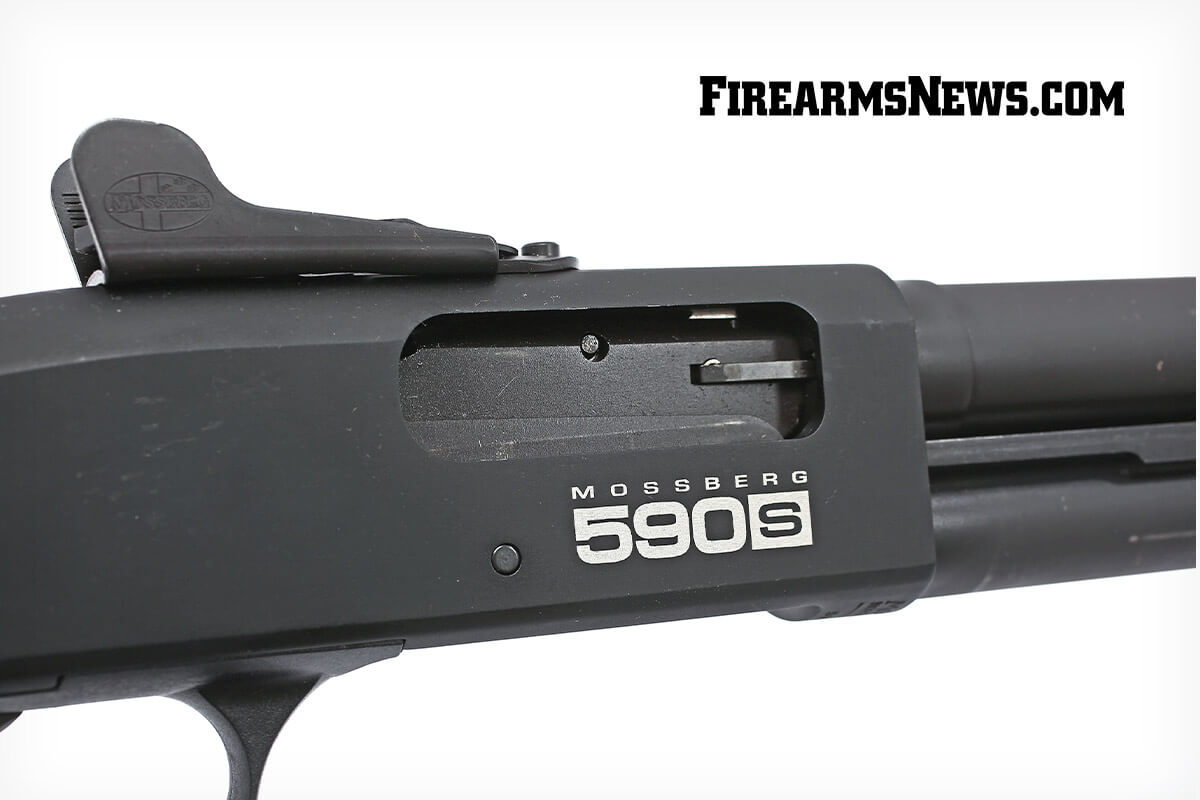
The 590 was itself an outgrowth of the 500, so let’s cover the essential details that work for both models, and how they compare to other pump shotguns. All of what I’m telling you I learned from being a gunsmith working on shotguns; hunting, defensive and competition, for over two decades. In all that time, the Mossbergs arrived the least-frequently in the shop, and when they did, it was for a few, specific, reasons. They were, and are, tough guns.
Comparisons
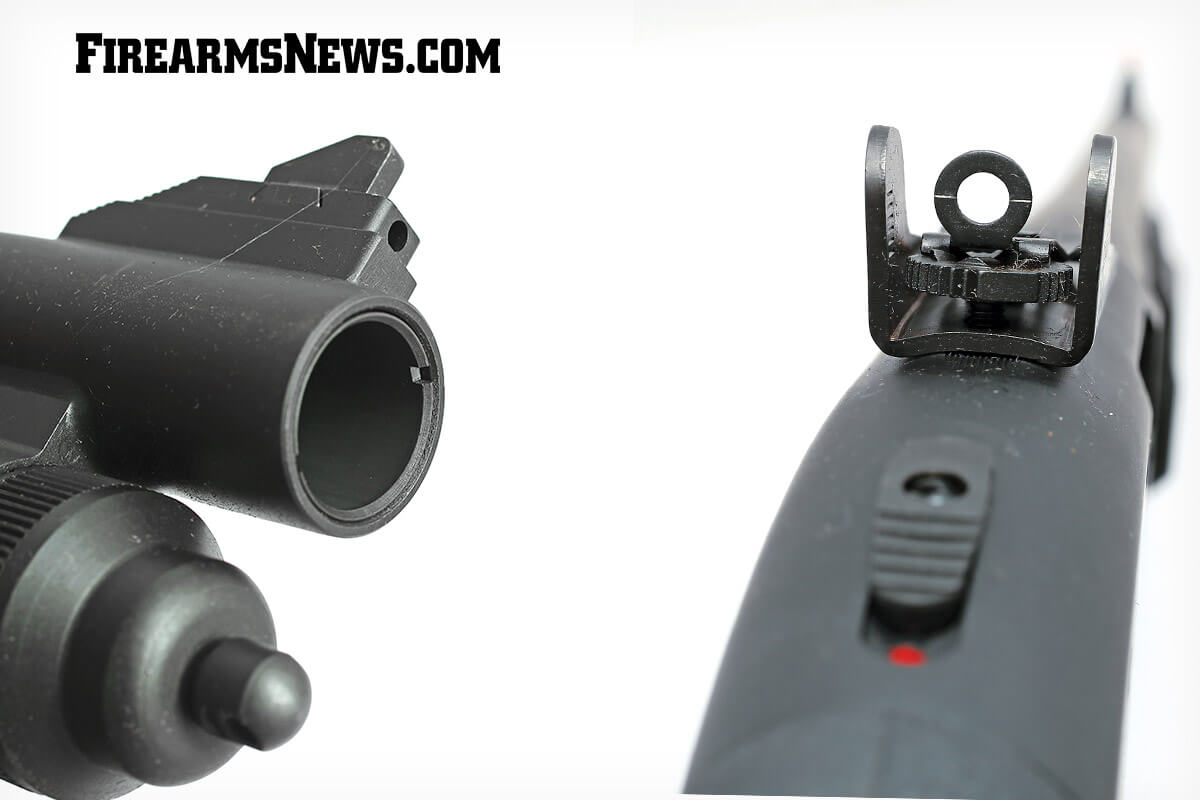
The Mossberg 500 differed from its competitors in several ways. First of all, the receiver is aluminum, not steel, and this allows the 500 (and the later 590) to be lighter for any given configuration than others can be. The blot has a pivoting locking block, and that hinges up when the action closes to lock into the barrel extension. So, despite the aluminum receiver, the Mossberg 500/590/590S has steel-to-steel lockup. There are dual extractors, to ensure the empty gets hauled out, and the ejector over-rides the internal extractor, leaving the outboard extractor to pitch the empty away. Which it does with enthusiasm and brio. The 500/590 has a tang safety, located on the upper rear of the receiver, which makes it equally handy for right and left-handed shooters. The usual cross-bolt safety only works well for right-handed shooters, and lefties have to adapt.
One aspect that makes the 500/590 a cinch to strip and clean, and to maintain, is that the shell stops are not pinned or staked in place. This takes some explaining. When you pump the action on a shotgun, it uses the dual action bars to work the action and spread the load evenly, while ejecting the fired empty, allowing the next one in the magazine tube to feed out at the correct moment in the cycle. It also has to stop the one behind that first one, so you don’t end up with two shells in the receiver, competing for the chamber. (That is a bad thing to have happen, by the way.) The shell stops take turns releasing and stopping shells. In the 870, the shell stops are spring steel and are staked into slots machined into the receiver interior. If they come loose, the 870 malfunctions. If this happens too often, the area for staking gets so chewed up from repeated staking that you can’t stake the stop or stops again. When that happens, you have to scrap the receiver. The 870, however, was a design that was an improvement over the forged and machined stops on the Winchester Model 12.
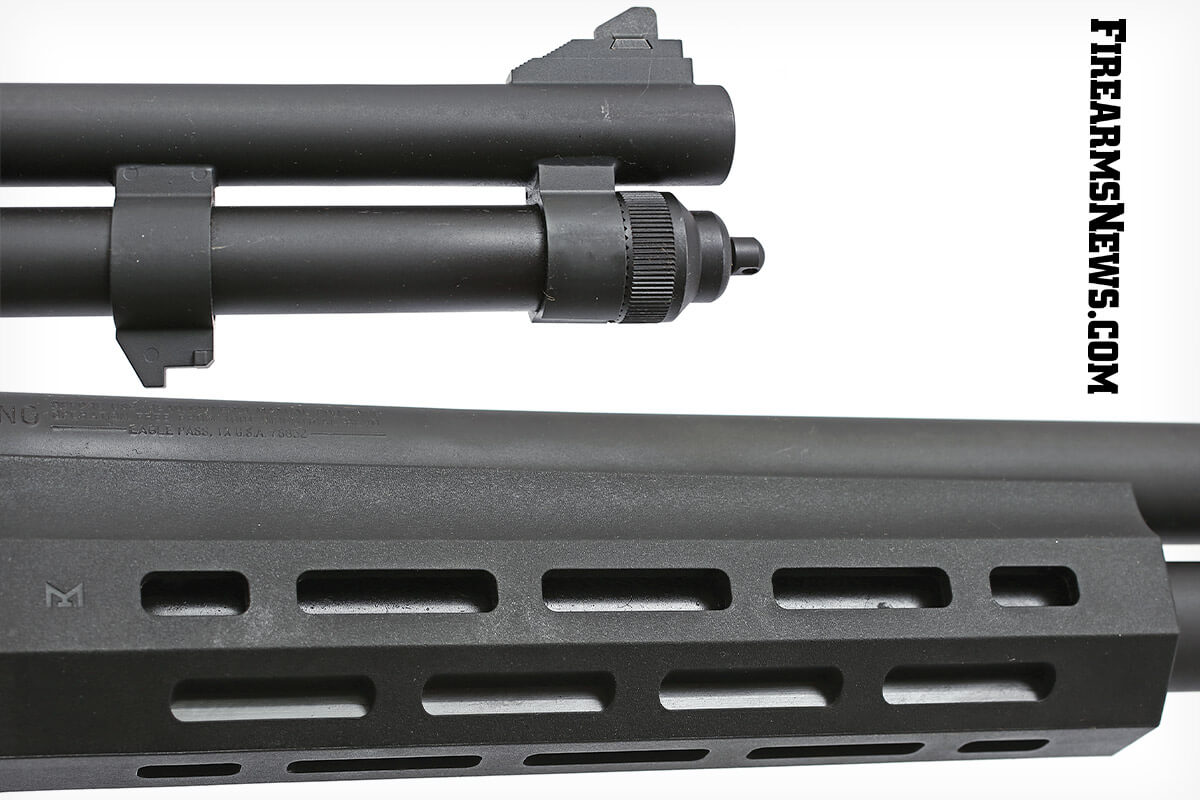
The Mossberg shell stops simply sit in their slots, held in place by the trigger guard. One has a small pivot boss, a short shaft that lets it flip up and down, the other just sits in its slot, and is pressed in and out by the forearm action rails. They do not need staking, they are designed to flex or rotate properly without being staked in place. You can lose them, you can break them, but you can’t mis-time them. You can’t even install them in the wrong slot. The 500/590 also differs from the others in that the trigger housing is plastic. Today we call it polymer, but back then, it was plastic. This lowers weight some more and keeps corrosion under control. The moving parts can rust, but the housing can’t, and that reduces the chances of the whole assembly freezing up. The rusty hammer, for example, can’t bind against a similarly rusty trigger housing, because plastic doesn’t rust. Now, there are drawbacks. You can break a Mossberg 500/590 trigger assembly. A hard enough blow will break the trigger guard or snap off the tabs holding the assembly into the receiver. But a similar blow to any other shotgun will also bend or break them.
High-Capacity
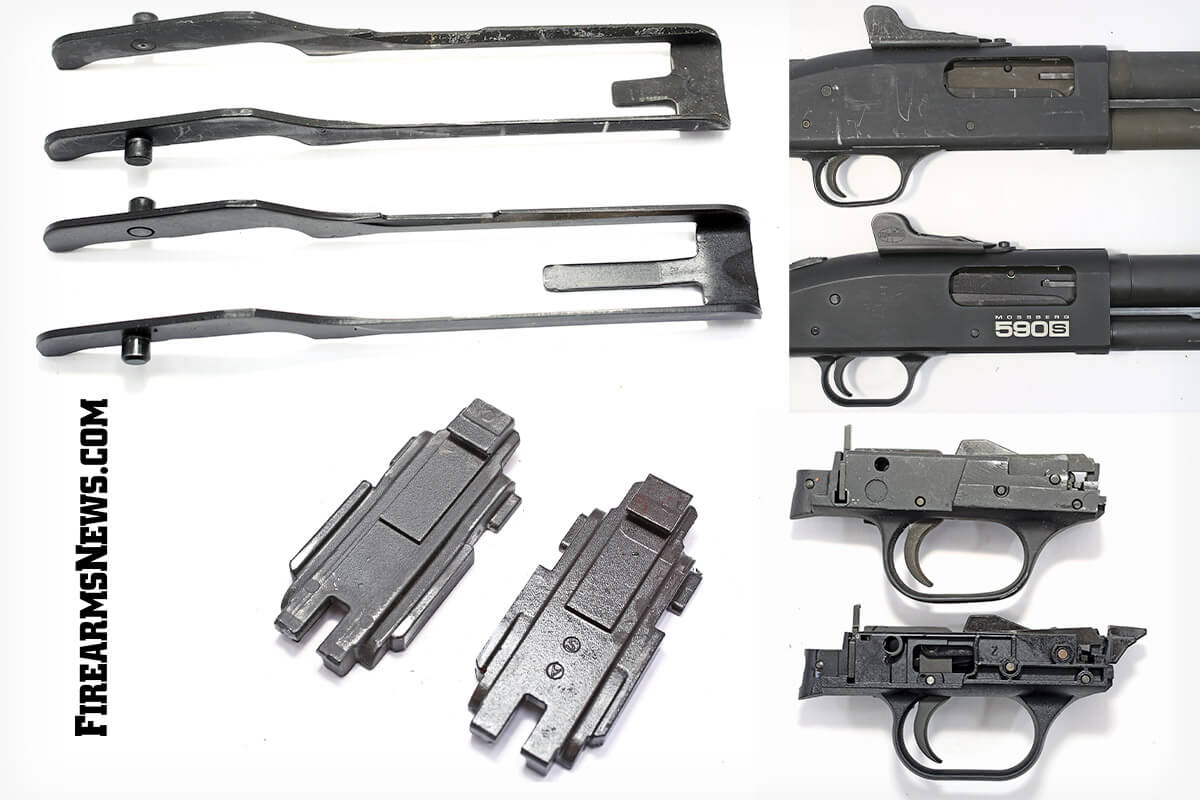
The magazine tube of the 500/590 is another improvement. On the 870 the magazine tube is brazed into the receiver. If you damage the tube, you have to replace the whole thing. The 500/590 magazine tube screws into the receiver, hand tight. If damaged, simply disassemble, unscrew the tube, replace with a new one, check function, and keep going. Now, this was something of a drawback with the 500, at least to some prospective shooters. Since the barrel screws into the end of the mag tube, and not around it, if you wanted to increase magazine capacity on a 500, you could not simply replace the magazine tube cap with an extension tube. You had to replace both the tube and the barrel, as well as a longer spring for the new tube, but Mossbergs were readily available with eight-shot mag tubes, so this wasn’t a problem for those who wanted such capacity.
Originally, the 500 (and pretty much all shotguns for a long time) came with wood stocks and wood forearms. Mossberg got onboard with the synthetic revolution from the start, and you could have your 500 with synthetic furniture. So, if the Model 500 was such a big improvement, with lower cost, less weight, and easier to maintain, why the 590? Because the government wanted shotguns. The closed end of the 500’s magazine tube made it difficult to clean the tube. You’d have to unscrew the tube from the receiver, which releases the spring and follower, and that’s not something the various armed services wanted the end-users doing. Plus, there was no way to mount a bayonet, and if you are going to be using a shotgun in a riot (can we call them riots anymore? I’m just asking.) Then you would probably find a bayonet a useful thing to have.
Well, Mossberg beefed up the barrel, and changed the end of the mag tube and the attachment system. The 590 barrel, instead of the secured thumbscrew of the 500, has two hoops that slide over the magazine tube, and the barrel is held in place by a magazine cap, screwed down onto the forward hoop. The barrel has thicker walls, the better to withstand the hard use troops would put it to, and the wide variety of ammunition they have to choose from. The second hoop has the bayonet lock tab on it, so a standard bayonet locks in place, and the front ring of the bayonet hilt snugs down over a boss on the magazine tube cap. For government use, Mossberg made the 590 in a matte finish, parkerized steel and matte-blasted aluminum anodized to match the black of the barrel and other steel parts. That turned out to be quite popular, and the 590 and other variants of the 500 have been available that way for many years now.
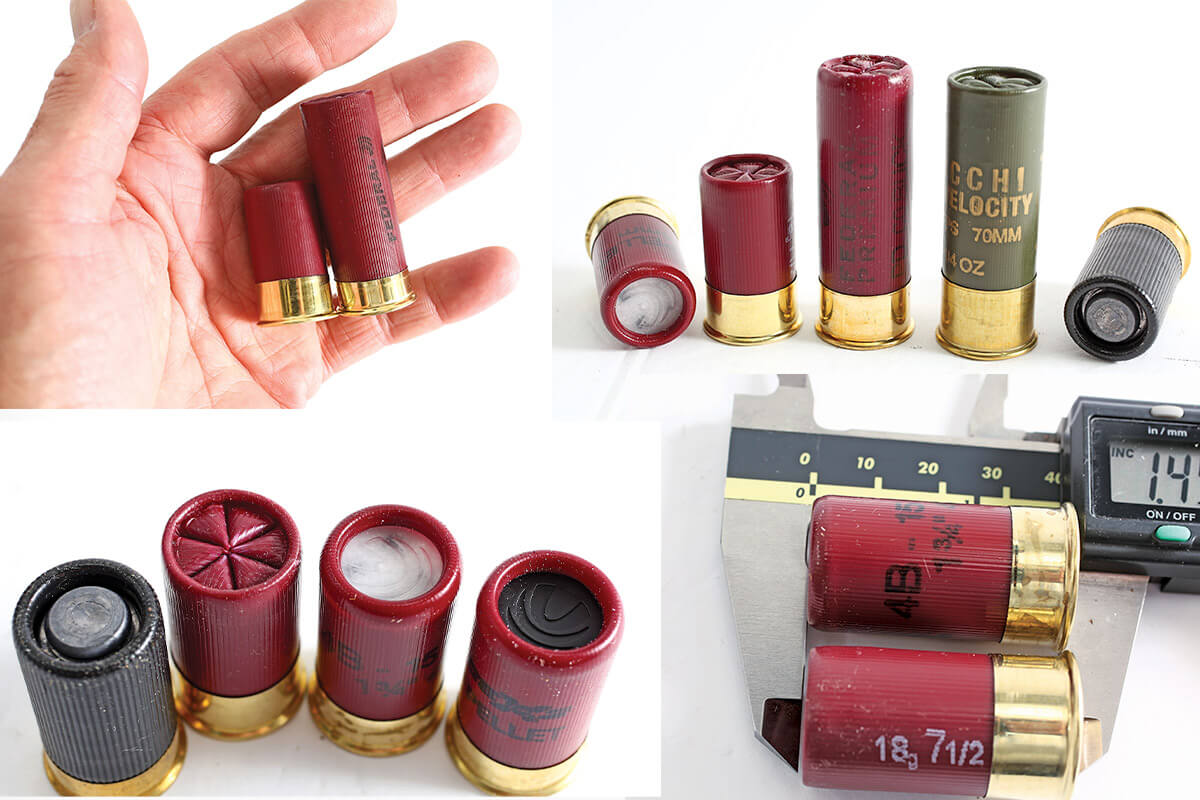
Oh, and capacity? That’s a bit of a touchy subject. You see, when you get a dozen shells in a tube, if there is even a fractional difference, you can gain or lose capacity. What I found was that the Aguila shorties were just a smidge shorter than the Federal ones, and as a result, I could shove 13 Aguilas in the mag tube, but only 12-1/2 of the Federal ones there. I’m not complaining, just letting you know Mossberg isn’t cheating your if you can only fit twelve and not thirteen shells into your 590S. The Federal shells were a loaded length just a bit more than the Aguilas, and that added up to over half an inch with twelve shells worth in the tube.
How do they do this? I mean, how do they get the 590S to feed the short ones? The difference between a 2-3/4-inch shell and a three-inch shell is not a problem. But getting the shorties to feed can be. Well, they did some redesigning and upgrading. I grabbed my 590A1 out of the rack and compared the parts. First, the elevator. That’s the part most of us call the lifter, and it takes the fed shell from the tube, and lifts it up into the path of the bolt, so the bolt can chamber it. They changed that to be more accommodating of differing lengths, with a longer center tab. Next, the bolt slide. That’s the flat plate the bolt rides on. It hooks onto the action bars, and the bolt slide can slide (hence the name) underneath the bolt, camming it down to unlock, and camming it up to lock. The shape of the bolt slide elevator slots time each shell, and Mossberg worked some magic there. I can see one slot is slightly different. And then they added an “energy absorbing bumper” to the front of the trigger housing. This acts to create a shortie-length elevator/lifter space, while still accommodating the longer cartridges. I could see no difference between the 590 and 590S when it came to the shell stops.

Could you re-build your 590 or 500 to feed shorties? Sure, if you yanked out the three parts mentioned, and installed “S” parts in their places, it would probably work. Will Mossberg sell those parts separately? I can’t imagine they would, not for a long time, as all they make will go into 590S builds, and inventory for warranty work. Now some of you are not all that keen on the ghost ring sights. This was advocated by, and taught at, Gunsite, by the late Jeff Cooper, and it is an excellent way to aim a shotgun. But it is not the traditional shotgun aiming system, which is and has been a bead sight. So, for those of you who prefer a bead sight, Mossberg offers the 590S with that, and lacking the bayonet lug on the barrel. The ghost ring version has a twenty-inch barrel, which the other has one eighteen and a half inches long. The shorter one is “only” a nine-plus-one capacity shotgun with the shorties. However, GG&G offers a magazine extension for the 590, fitting the 590S, that would gain you another two or three shorties.
Shorties vs. Full Shells

In testing, I found the 590S worked just fine with all the loads I had to test; shorties and 2-3/4-inch shells, birdshot, buckshot and slugs. In scouring the ammo bunker, I found that I had not one single three-inch 12 gauge shell to test the 590S with. Some of you may see this as a shocking oversight on my part, but I ascribe it to common sense. Unless you are shooting geese, or finishing off crippled B17s, I don’t see a need for three-inch 12 gauge shells. And I certainly don’t like the recoil. One detail in a shotgun with shorties is handling the shells. I have been shooting shotguns since LBJ was President, and I have to confess the first time I handled them, my hands kept telling me “something’s wrong.” They just don’t feel right. I got over it, and you will too.
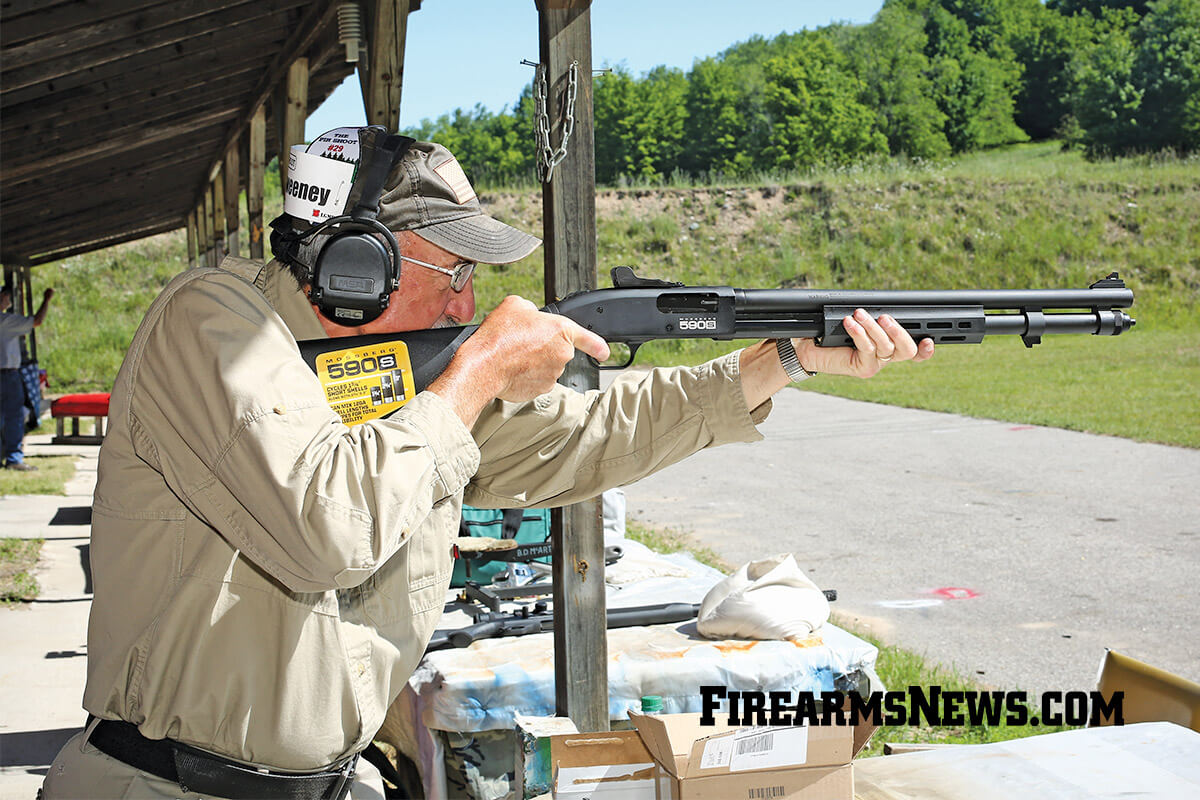
The 590S in the twenty-inch version comes with the barrel machined for the Accu-choke system, and they ship it with a cylinder choke installed. The 18.5-inch barrel version is a straight cylinder bore choke. I found that the ghost ring version I had shot buckshot just a little wider than I like, with ten-yard patterns running eight inches or so. The buckshot using pattern-control wads did better, and as with all shotguns, you’ll have to test yours to see what it prefers, and make it perform to your satisfaction. That’s the beauty of screw-in chokes. I had The Pin Shoot on my schedule, so I packed the 590S along to give it some testing. In group-shooting, I found that even with the cylinder bore it shot groups really well. While I placed second in the 12×8 slug match with my regular shotgun, I think I’ll have to reconsider the Mossberg 590S for next year. In the short testing I did, it took the plates down (those are the targets, falling plates, with slugs) very well. Why the 590S, then? In the 12×8 Event, you get a full second off your time for using a pump, and another for using iron sights. With the winning score of 10.2 seconds this year, getting a two-second bonus is very attractive. Very attractive.
Maybe I should not be too hasty in returning this shotgun. If I added a rifled choke tube, and had Mag Na Port do a full-house Pigeon Port job to it, hmmm, the future looks rosy. Even if you are not going to travel north and enter The Pin Shoot, the Mossberg 590S is very attractive. With pump reliability, the capacity of shortie shells, and your choice of ghost ring or bead sights, there’s a lot to be had there.
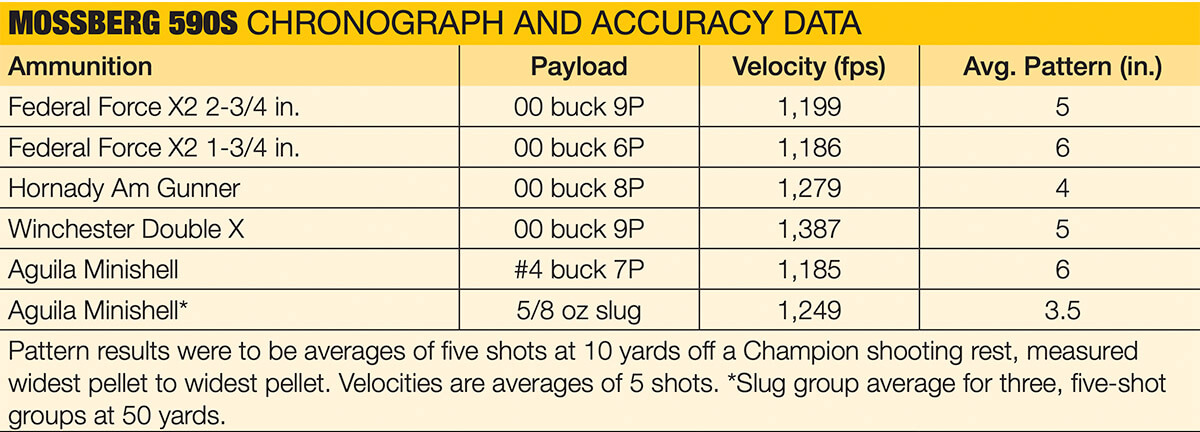
Mossberg 590S Specs
- Type: Hammer-fire, pump-action
- Caliber: 12 Gauge
- Capacity: 8+1 rds. (7+1 rds. w/ 3in., 13+1 rds. w/ 1.75 in.)
- Barrel: 20 in.
- Overall Length: 41 in.
- Weight: 7 lbs., 4 oz.
- Finish: Black oxide steel
- Sights: Ghost ring rear, blade front
- Trigger: 4 lbs., 9 oz.
- MSRP: $753
- Manufacturer: O.F. Mossberg & Sons, Inc.
About the Author
Patrick Sweeney is a life-long shooter, with more than half a century of trigger time, four decades of reloading, 25 years of competition (4 IPSC World Shoots, 50 USPSA Nationals, 500+ club matches, and 18 Pin Shoots, as well as Masters, Steel Challenge and Handgunner Shootoff entries). He spent two decades as a professional gunsmith, and two decades as the President of his gun club. A State-Certified law Enforcement Firearms Instructor, he is also a Court-recognized Expert Witness.
If you have any thoughts or comments on this article, we’d love to hear them. Email us at FirearmsNews@Outdoorsg.com.








